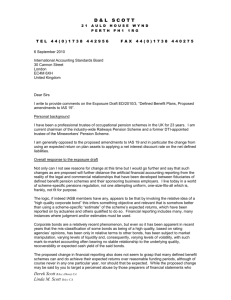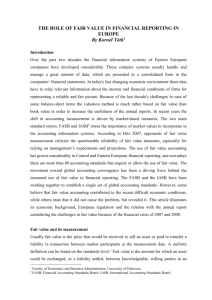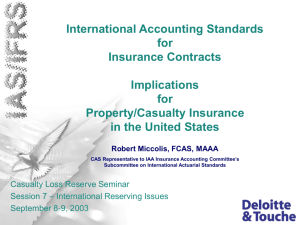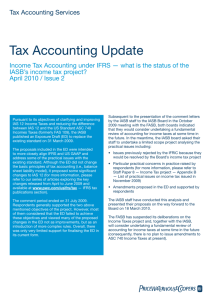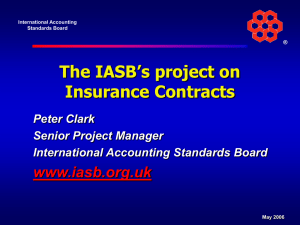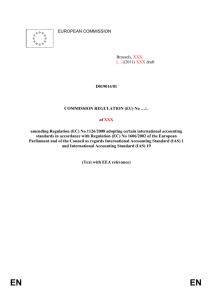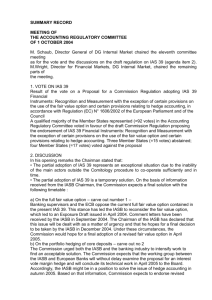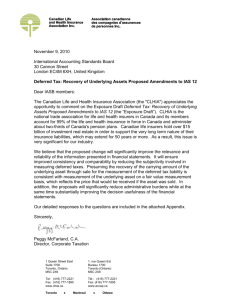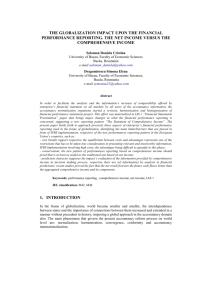Response to IASB exposure draft on recognition
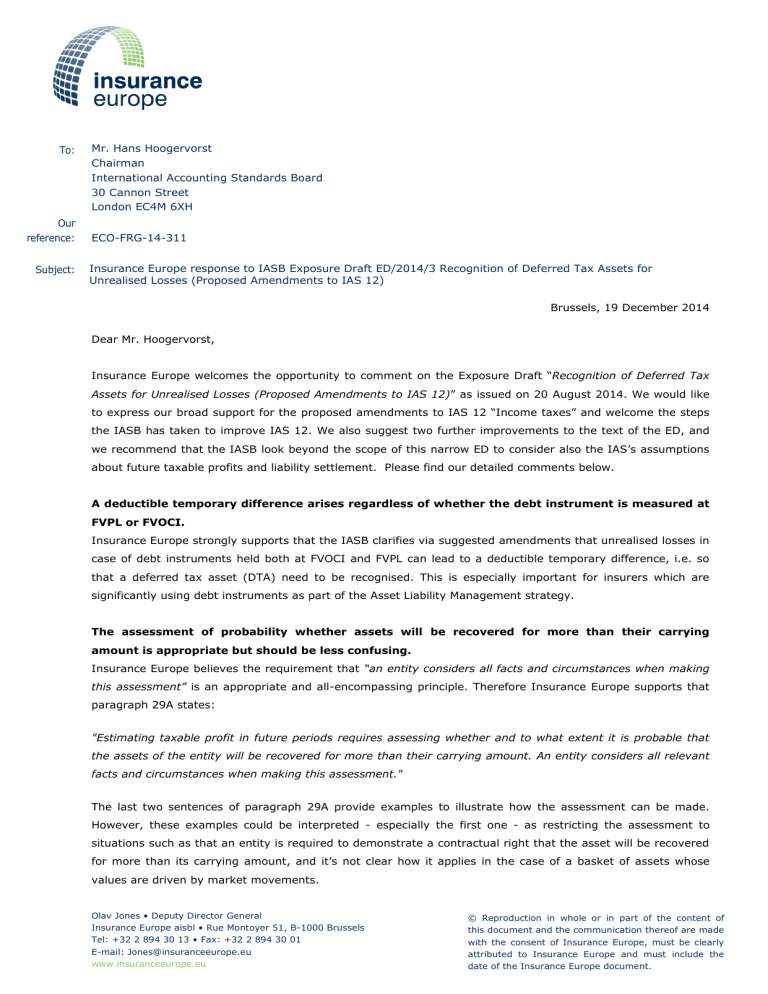
To: Mr. Hans Hoogervorst
Chairman
International Accounting Standards Board
30 Cannon Street
London EC4M 6XH
Our reference: ECO-FRG-14-311
Subject: Insurance Europe response to IASB Exposure Draft ED/2014/3 Recognition of Deferred Tax Assets for
Unrealised Losses (Proposed Amendments to IAS 12)
Brussels, 19 December 2014
Dear Mr. Hoogervorst,
Insurance Europe welcomes the opportunity to comment on the Exposure Draft “ Recognition of Deferred Tax
Assets for Unrealised Losses (Proposed Amendments to IAS 12) ” as issued on 20 August 2014. We would like to express our broad support for the proposed amendments to IAS 12 “Income taxes” and welcome the steps the IASB has taken to improve IAS 12. We also suggest two further improvements to the text of the ED, and we recommend that the IASB look beyond the scope of this narrow ED to consider also the IAS’s assumptions about future taxable profits and liability settlement. Please find our detailed comments below.
A deductible temporary difference arises regardless of whether the debt instrument is measured at
FVPL or FVOCI.
Insurance Europe strongly supports that the IASB clarifies via suggested amendments that unrealised losses in case of debt instruments held both at FVOCI and FVPL can lead to a deductible temporary difference, i.e. so that a deferred tax asset (DTA) need to be recognised. This is especially important for insurers which are significantly using debt instruments as part of the Asset Liability Management strategy.
The assessment of probability whether assets will be recovered for more than their carrying amount is appropriate but should be less confusing.
Insurance Europe believes the requirement that “an entity considers all facts and circumstances when making this assessment” is an appropriate and all-encompassing principle. Therefore Insurance Europe supports that paragraph 29A states:
"Estimating taxable profit in future periods requires assessing whether and to what extent it is probable that the assets of the entity will be recovered for more than their carrying amount. An entity considers all relevant facts and circumstances when making this assessment."
The last two sentences of paragraph 29A provide examples to illustrate how the assessment can be made.
However, these examples could be interpreted - especially the first one - as restricting the assessment to situations such as that an entity is required to demonstrate a contractual right that the asset will be recovered for more than its carrying amount, and it’s not clear how it applies in the case of a basket of assets whose values are driven by market movements.
Olav Jones • Deputy Director General
Insurance Europe aisbl • Rue Montoyer 51, B-1000 Brussels
Tel: +32 2 894 30 13 • Fax: +32 2 894 30 01
E-mail: Jones@insuranceeurope.eu www.insuranceeurope.eu
© Reproduction in whole or in part of the content of this document and the communication thereof are made with the consent of Insurance Europe, must be clearly attributed to Insurance Europe and must include the date of the Insurance Europe document.
As a consequence, Insurance Europe recommends that the two last sentences of the new paragraph 29A are deleted. We believe the standard will improve without the explanatory paragraphs of how facts and circumstances should be assessed because these sentences are not needed as an explanation and could be overly prescriptive.
The IAS 12 amendments should be aligned with IAS 39 as well as IFRS 9.
We understand that the current proposals refer to existing classification categories in IAS 39 Financial
Instruments: Recognition and Measurement. We would however propose that the proposals should also be aligned with the principles of IFRS 9 Financial Instruments as issued by the IASB on 24 July 2014.
The financial reporting principles regarding income taxes (IAS 12) require further thinking on the conceptual approach on recognition of deferred tax assets.
Overall, we believe that deductible temporary differences related to unrealised losses on debt instruments measured at fair value should be recognised as deferred tax assets without the requirement that those would lead to a probable reduction in future tax payments when the temporary deductible differences are expected to reverse over time.
Furthermore, according to the currently ongoing IASB’s insurance contracts project “IFRS 4 phase II”, insurance liabilities will have to be recognised at current value including the impact of discount rate changes which will reverse fully over time. This example, among others, shows that the IASB should also address the expected treatment for liabilities and not limit the amendments to assets. Indeed, we believe that the assessment of future taxable profits should also consider whether it is probable that the liabilities of the entity will be settled for less than their carrying amount.
Please feel free to contact us should you have any further questions or comments.
Yours sincerely,
Olav Jones
Director Economics & Finance / Deputy Director General
2


